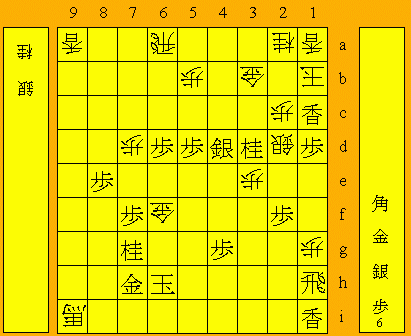38th Oi Match Game 4
Black: Habu Yoshiharu, Oi
White: Sato Yasumitsu, Challenger
38th Oi-sen, Game 4, August 18th and 19th 1997
1.P7g-7f 1/1 0/0
2.P8c-8d 0/1 4/4
An interesting choice by challenger Sato. He is probably an expert on the
Yagura opening and has written several good books on the opening. However,
lately the results by white in the Yagura have not been very good.
3.S7i-6h 4/5 0/4
4.P3c-3d 0/5 1/5
5.P6g-6f 1/6 0/5
6.S7a-6b 0/6 1/6
7.P5g-5f 2/8 0/6
8.P5c-5d 0/8 2/8
9.S3i-4h 4/12 0/8
10.S3a-4b 0/12 1/9
11.G4i-5h 2/14 0/9
12.G4a-3b 0/14 0/9
13.G6i-7h 1/15 0/9
14.K5a-4a 0/15 0/9
15.K5i-6i 1/16 0/9
16.P7c-7d 0/16 4/13
17.G5h-6g 4/20 0/13
18.G6a-5b 0/20 0/13
19.S6h-7g 7/27 0/13
20.S4b-3c 0/27 2/15
21.B8h-7i 4/31 0/15
22.B2b-3a 0/31 1/16
23.P3g-3f 4/35 0/16
24.P4c-4d 0/35 1/17
25.S4h-3g 13/48 0/17
26.B3a-6d 0/48 13/30
27.B7i-6h 5/53 0/30
28.G5b-4c 0/53 4/34
29.K6i-7i 2/55 0/34
30.K4a-3a 0/55 2/36
31.K7i-8h 3/58 0/36
32.K3a-2b 0/58 8/44
33.S3g-4f 26/84 0/44
34.S6b-5c 0/84 11/55
35.N2i-3g 4/88 0/55
36.B6d-7c 0/88 5/60
37.P2g-2f 52/140 0/60
38.S3c-2d?! 0/140 5/65
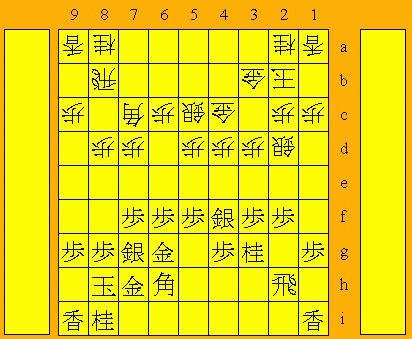
A standard move that has been played in this position many times before, but
this game shows that it might be a dubious move if black does not play the
attack with N2e. There are three main problems with this move and all come out
in this game. One problem is that it opens the diagonal to the white king by
opening square 3c. The second problem is that the white king now has one
defender less for protection. The third problem is that knight drops on both
3d and 1d will become possible in the future.
39.P1g-1f 0/140 0/65
40.P1c-1d 0/140 6/71
41.R2h-5h 2/142 0/71
42.P4d-4e 0/142 35/106
43.N3gx4e 33/175 0/106
44.S5c-4d 0/175 0/106
45.R5h-1h 25/200 0/106
46.P8d-8e 0/200 9/115
47.P6f-6e 24/224 0/115
48.P6c-6d 0/224 116/231
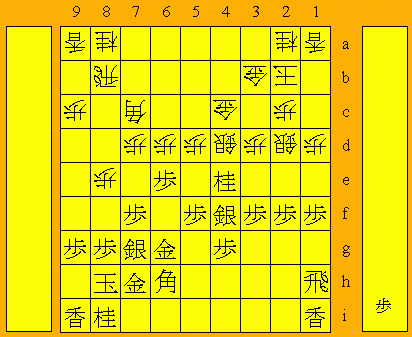
The sealed move and also a new idea. Morishita played 48.Sx4e Sx4e N*3c in the
Kio match against Habu.
49.S7g-6f 22/246 0/231
50.R8b-6b 0/246 7/238
51.P6ex6d 23/269 0/238
52.R6bx6d 0/269 5/243
53.P*6e 1/270 0/243
54.R6d-6a 0/270 3/246
55.P9g-9f 18/288 0/246
56.P9c-9d 0/288 4/250
57.B6h-7g 1/289 0/250
Black has succeeded in exploiting problem one mentioned above. The bishop is
now on the long diagonal to the white king that white has opened by playing
S2d.
58.B7c-8d 0/289 28/278
59.P3f-3e 6/295 0/278
Making room for a knightdrop on 3d.
60.P3dx3e 0/295 14/292
61.P5f-5e 2/297 0/292
62.N8a-7c 0/297 18/310
63.P5ex5d 21/318 0/310
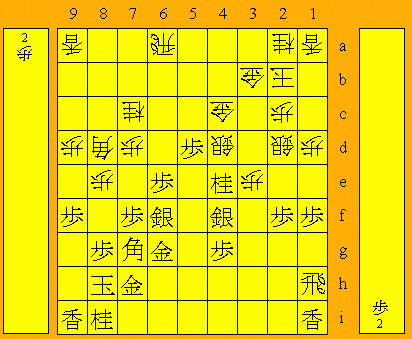
64.P*5b 0/318 4/314
Painful defence-only move. This move makes a later P5c+ a little less
problematic, but this move is still possible. More importantly, white can never
drop a pawn on the fifth file himself. However, taking with the gold leaves
the white king too exposed after 64.Gx5d P*3c Nx3c Nx3c+ S2dx3c N2e. Here
we see how the second problem of the silver on 2d influences white's options.
65.P6e-6d! 24/342 0/314
Great move that makes clear that Habu is now dictating this game. White can
not take this pawn, since after 65.Rx6d S6f-5e Sx5e Bx5e he loses the rook.
If only the silver was still on 3c...
66.P9d-9e 0/342 29/343
White is forced into a desperate attack. If he waits, he will be slowly pushed
off the board.
67.P9fx9e 0/342 0/343
68.P8e-8f 0/342 1/344
69.B7gx8f 18/360 0/344
70.P*9g 0/360 1/345
71.L9ix9g 14/374 0/345
72.N7c-8e 0/374 2/347
73.L9g-9f 0/374 0/347
74.B8d-7c?! 0/374 3/350
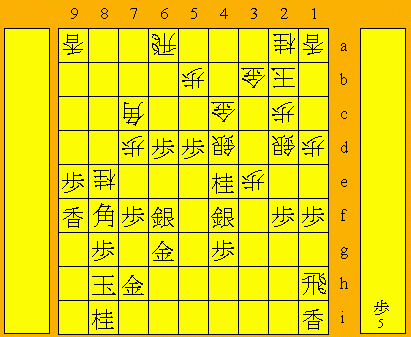
This gives black an extra move. 74.Gx5d is better, but after N7g the knights
are exchanged and this leaves a gaping hole on 3d for a devastating knightdrop.
Problem number three is probably the biggest problem of all.
75.S6f-6e 12/386 0/350
76.S4dx4e 0/386 2/352
77.S4fx4e 11/397 0/352
78.N*8d 0/397 1/353
79.K8h-7i 1/398 0/353
80.N8dx9f 0/398 2/355
81.K7i-6h 13/411 0/355
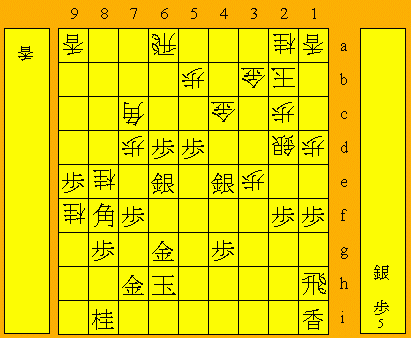
Black moves the king away from danger.
82.L*5e? 0/411 30/385
This turns out to be a bad move, transforming white's bad position in a losing
one. The last fighting chance was 82.B8d N7g L*6f Nx8e N8h+ and after Gx8h
Lx6g+ Kx6g G*6f white picks up the silver on 6e and has good chances to win.
However, after N8h+ B7g! black still has the advantage.
83.G6g-6f 14/425 0/385
84.B7cx9e 0/425 9/394
85.G6fx5e 3/428 0/394
86.N9f-8h+ 0/428 2/396
87.G7hx8h 5/433 0/396
88.B9ex8f 0/433 0/396
89.P8gx8f 0/433 0/396
90.B*6f 0/433 0/396
91.G8h-7h 0/433 0/396
92.B6fx5e 0/433 0/396
93.P8fx8e 0/433 0/396
94.B5e-9i+?! 0/433 51/447
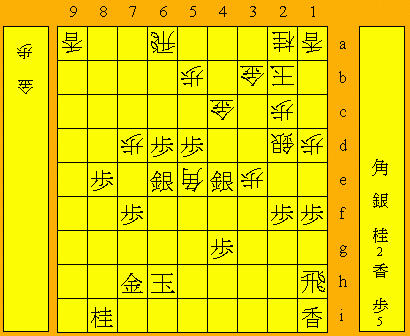
Now the game is over quickly. Better is 94.L9h+ N*3d Gx3d Sx3d +L8h G7g. But
even then black still has a winning position.
95.N8i-7g 3/436 0/447
96.G*5e 0/436 11/458
97.N*3d 16/452 0/458
98.K2b-1b 0/452 0/458
99.N*4d 3/455 0/458
100.G4cx4d 0/455 1/459
101.S4ex4d 0/455 0/459
102.G5ex6e 0/455 0/459
103.P1f-1e 4/459 0/459
104.G6e-6f 0/459 5/464
105.P1ex1d 1/460 0/464
106.P*1g 0/460 0/464
107.L*1c 2/462 0/464
Resigns 0/462 0/464
Time: 07:42:00 07:44:00
After 108.Nx1c G*2b Gx2b Nx2b+ Kx2b Px1c+ Kx1c (Lx1c or Sx1c then N*3d) Rx1g
P*1e P*1d Kx1d Rx1e Sx1e S*2e K1c Lx1e K2b S*3c or 108.Sx1c Px1c+ Nx1c G*2b
white is mated. These variations are quite long, but straightforward and not
hard to read out for a professional. A good game by Habu, who outplayed Sato
in this game and now is only one win away from his fifth consecutive Oi title,
which will make him Lifetime Oi.
